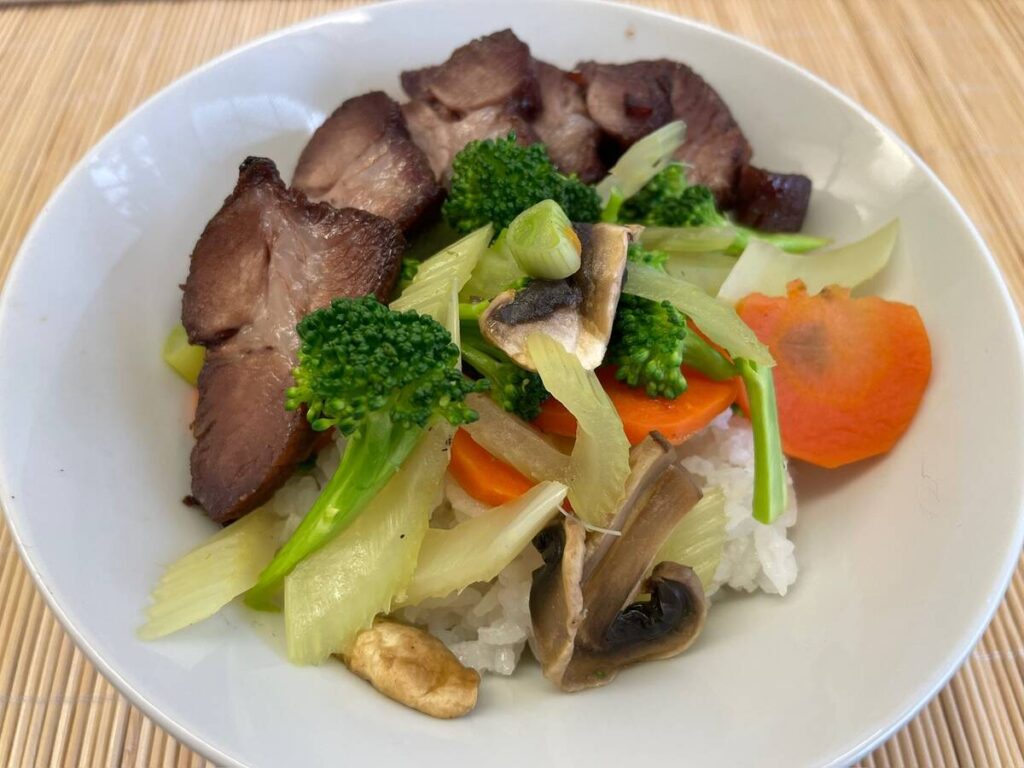Versatile Chinese barbecue pork has a variety of uses

Chinese barbecue pork, or char siu, is a delicious, authentic Cantonese roasted meat that has a salty/sweet flavour along with a hint of spice. It is flavourful enough to stand alone with plain rice and steamed vegetables or enjoy as a sandwich. The bonus is that it makes a delicious addition to fried rice, stir-fries, noodle dishes and wonton soup. It is an easy, but time-consuming, recipe that will add a new dimension to home-prepared Asian recipes. Make a double batch and freeze the extra to add to future recipes.
Serves eight.
- 3 lb. boneless pork shoulder or pork butt (the fat adds extra flavour) * 1.5 kg
- 1/4 c. white sugar 60 mL
- 2 tsp. salt 10 mL
- 1/2 tsp. Chinese five spice powder 2 mL
- 1/4 tsp. white pepper 1 mL
- 1/2 tsp. sesame oil 2 mL
- 1 tbsp. Shaoxing rice wine (or dry cooking sherry) optional 15 mL
- 1 tbsp. soy sauce 15 mL
- 1 tbsp. hoisin sauce 15 mL
- 2 tsp. fancy molasses 10 mL
- 1/8 tsp. red food coloring .5 mL, optional
- 3 cloves finely minced garlic
- 2 tbsp. maltose or honey 30 mL
- 1 tbsp. hot water 15 mL
- *Fresh pork shoulder or pork butt, with a good layer of fat, will be more tender and flavourful than leaner pork loin or tenderloin.
Cut pork into long 1 1/2 to 2-inch (3 to 4 cm) thick pieces. Look for where the fat and/or membrane separates the muscle and use a sharp knife to follow along these muscle membrane lines.
The result generally has the fat and tougher membrane on the outside, protecting the tender meat and keeping it juicy during roasting.
The marinade and heat will break down the membrane, so it won’t be tough.
Read Also


Less allergenic wheat line developed
Scientists at the University of California, Davis, have discovered that certain gluten proteins are most responsible for severe reactions in people with celiac disease.
Once the meat is separated, cut into manageable size pieces that can be turned easily and will cook evenly. Thicker pieces may need to be butterflied to get to the desired thickness.
To do this, start where the meat begins to thicken and cut into the thickest part. Don’t cut all the way through — leave about an inch (2 cm) and spread the meat open like a book or butterfly.
Make the marinade or barbecue sauce by combining sugar, salt, five spice powder, white pepper, sesame oil, wine, soy sauce, hoisin sauce, molasses, food colouring (if using) and garlic in a bowl.
Reserve about two tablespoons (30 mL) of marinade, cover and refrigerate for later.
Rub pork with remaining marinade in a large bowl or baking dish and cover, or place in a large sealable plastic bag. Refrigerate overnight, or at least eight hours. Turn meat a couple of times to ensure meat is well marinated.
Preheat oven to 475 F (245 C). Position rack in upper third of oven.
Line a baking sheet with foil and place a metal rack on top. This will keep pork off the pan and allow it to roast more evenly.
Place pork on rack, leaving as much space as possible between pieces.
Transfer baking sheet to preheated oven. To prevent drippings from burning or smoking, pour 1 1/2 cups (375 mL) water into pan below rack.
Roast for 10 minutes and then reduce oven temperature to 375 F (190 C).
After an additional 15 minutes, flip pork. Add more water if needed. Turn pan 180 degrees to ensure even roasting.
Roast another 15 minutes.
Throughout roasting time, check meat about every 10 minutes to ensure that the meat is not burning. Reduce oven temperature if needed.
While pork is cooking, heat maltose or honey in microwave to liquefy, combine with reserved marinade and one tablespoon (15 mL) hot water to make basting sauce.
After 40 minutes total roasting time, baste pork, flip it and baste other side. Roast for a final 10 minutes.
When the pork has cooked for 50 minutes total, it should be cooked through and caramelized on top. If it’s not caramelized sufficiently, turn broiler on for a couple minutes to crisp the outside and add some colour/flavour to the pork. Remain watchful because the sweet char siu barbecue sauce can burn quickly.
Use a meat thermometer to check if the internal temperature of the pork has reached 160 F (71 C), as recommended by Health Canada.
Remove from oven and baste with the last bit of sauce. Let meat rest for 10 minutes before slicing.
To cook on the barbecue
This requires constant attention to prevent burning the meat.
Preheat grill to 500 F (260 C) to sear the meat to seal in juices before the meat is turned, about three minutes. Once both sides of meat are seared, turn heat down to 375 F (190 C).
Turn meat every two to three minutes and baste after each turn to keep moist and flavourful. Continue for 20 to 30 minutes. Stop basting a few minutes before removing meat from barbecue because the marinade was in contact with raw meat.
Use a meat thermometer to check if the internal temperature of the pork has reached 160 F (71 C)
Adapted from thewoksoflife.com.
Barbecue pork with Chinese vegetables
A variety of fresh vegetables stir fried with slices of Chinese char siu barbecue roast pork make a quick, healthy and delicious meal.
Serves four.
- 1 tbsp. regular soy sauce 15 mL
- 1/2 tsp. salt 2 mL
- 1/4 tsp. sugar 1 mL
- 1/2 tsp. sesame oil 2 mL
- 1 tsp. oyster sauce 5 mL
- freshly ground white pepper
- 1 tbsp. cornstarch 15 mL
- 1 tbsp. water 15 mL
- 1 tbsp. canola or vegetable oil 15 mL
- 1/2 tsp. ginger (minced) 2 mL
- 2 cloves garlic (minced)
- 1/2 c. fresh button or baby portabella mushrooms, thinly sliced 125 mL
- 1/4 c. red bell pepper, sliced thinly lengthwise 60 mL
- 1/4 c. bamboo shoots, rinsed and drained 60 mL
- 1/4 c. sliced water chestnuts, rinsed and drained 60 mL
- 1 tbsp. Shaoxing wine or dry cooking sherry 15 mL
- 8 oz. Chinese barbecue roast pork (char siu), thinly sliced 225g
- 3 to 4 c. large white bok choy, cut into ¾-inch wide x 2-inch lengths 750 – 1000 mL
- 1 c. snow peas, washed and trim ends 125 mL
- 1/2 c. hot chicken stock 125 mL
Combine soy sauce, salt, sugar, sesame oil, oyster sauce and fresh ground pepper and set aside.
Combine cornstarch and water and set aside.
Prepare all the vegetables and set aside.
It is essential that all the sauces and vegetables are prepared before beginning to cook because the dish is cooked and assembled very quickly.
Heat wok over medium high heat and add one tablespoon of oil around perimeter of wok.
Immediately add minced ginger and fry for five to 10 seconds.
Stir in minced garlic and immediately add mushrooms and red bell peppers. Stir fry for 15 seconds.
Turn heat up to high, and add bamboo shoots, water chestnuts and Shaoxing wine. Stir-fry for another 10 seconds.
Add barbecue pork. Stir-fry for 20-30 seconds.
Add bok choy, give a good stir and fry for 15 seconds.
Add soy sauce mixture.
Continue to stir-fry for another 20 seconds.
Add snow peas and stir until they are evenly distributed. Then add chicken stock and let mixture come to a boil.
Stir in half of cornstarch thickener and cook for 20 seconds, until sauce thickens and coats the back of a spoon. Add more cornstarch mixture if sauce seems thin and if there is too much standing liquid. Add more chicken stock if the dish isn’t saucy enough.
Check taste and add more soy sauce, oyster sauce or salt.
Plate and serve with steamed rice.
Adapted from thewoksoflife.com.
Roast pork lo mein
Serves four.
Sauce mixture
- 1 tbsp. light soy sauce 15 mL
- 2 tsp. dark soy sauce 10 mL
- 1 tbsp. oyster sauce 15 mL
- 1 tbsp. hot water 15 mL
- 1/4 tsp. sugar 1 mL
- 1/2 tsp. salt 2 mL, or to taste
- 1/8 tsp. ground white pepper .5 mL
- 1/2 tsp. sesame oil 2 mL
Rest of the dish
- 8 ounces Chinese roast pork (char siu) julienned into strips 225 g
- 1 clove garlic, minced
- 1/4 c. carrot, julienned 60 mL
- 1/2 c. water chestnuts, sliced 125 mL
- 1/2 c. canned bamboo shoots, in strips or sliced into bite-sized pieces 125 mL
- 1/2 c. sliced mushrooms, shiitake, oyster, button, or baby Portobello 125 mL
- 2 1/4 c. napa cabbage or suey chow, shredded 560 mL
- 2/3 c. snow peas, ends trimmed and fibrous string removed 150 mL
- 14 ounces cooked lo mein noodles, boiled according to package instructions 400 g
- 1 1/2 tbsp. vegetable oil 22 mL
- 1 tbsp. Shaoxing wine 15 mL
- 2 scallions (julienned)
Combine light soy sauce, dark soy sauce, oyster sauce, hot water, sugar, salt, white pepper and sesame oil in a small bowl. Set aside.


Prepare and cut the barbecue pork and vegetables.
Cook noodles according to package instructions until al dente, rinse in cold water and drain thoroughly. Set aside.
Heat wok over medium heat. Add oil and garlic. After 10 seconds, add carrots, water chestnuts, bamboo shoots and mushrooms. Increase heat to high and stir-fry for one minute.
Add pork and stir-fry for 20 seconds. Add Shaoxing wine around the perimeter of the wok.
Give everything a quick stir and add cabbage and noodles. If noodles are stuck together, rinse in warm water.
Pour sauce over noodles and stir-fry with a scooping motion for one to two minutes, or until the sauce is evenly distributed.
Add snow peas and scallions. Continue stir-frying until noodles are heated through and everything is thoroughly mixed. If the noodles become sticky, add two or more tablespoons of water until they loosen up.
Taste and adjust seasonings. Serve with hot sauce on the side.
Adapted from thewoksoflife.com.
Betty Ann Deobald is a home economist from Rosetown, Sask., and a member of Team Resources. Contact: team@producer.com.
Source: producer.com


